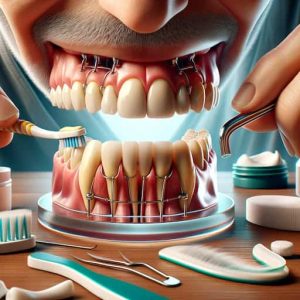Article At A Glance
- Understanding different types of dental bridges and their costs.
- Steps to find reputable and affordable dental practices in Manchester.
- Exploring insurance options and financing for dental bridges.
- How to maintain your dental bridge to maximize its lifespan.
- Answers to frequently asked questions about dental bridges.

Discovering Your Options for Dental Bridges in Manchester
When you’re missing a tooth, it affects more than just your smile. It can impact how you eat, speak, and feel about yourself. Dental bridges are a popular solution, and they come in different types, each with its own benefits and cost considerations. In Manchester, finding a budget-friendly option for dental bridges means understanding what’s available and what suits your needs.
Evaluating Bridge Types: From Traditional to Cantilever
There are several types of dental bridges, and the cost can vary significantly depending on the type you choose. Let’s break it down:
- Traditional bridges are the most common, involving a false tooth held in place by dental crowns on each side. These are typically used when you have natural teeth on both sides of the gap.
- Cantilever bridges are similar, but the false tooth is supported by a crown on only one side. This is an option when there are teeth on just one side of the missing tooth.
- Implant-supported bridges use dental implants instead of crowns or frameworks. These are more stable and feel more like natural teeth but are also the most expensive option.
Most importantly, when considering the cost, remember that the least expensive option upfront may not always be the most cost-effective over time. For example, an implant-supported bridge has a higher initial cost but may require less maintenance and last longer than a traditional bridge.
Identifying Credible Dental Practices in Manchester
Finding the right dental practice is crucial. You want a team that not only offers affordable options but also delivers quality care. Here’s how you can find a reputable clinic:
- Look for practices with good reviews and testimonials from other patients.
- Check for qualifications and experience in cosmetic dentistry, particularly in fitting dental bridges.
- Visit the clinic for a consultation to discuss options and get a feel for the environment and the staff.
Remember, a trustworthy practice will be transparent about costs and provide a detailed treatment plan.
Factors Affecting the Cost of Dental Bridges
The cost of dental bridges can be influenced by several factors:
- Materials: Porcelain, ceramic, and metal alloys vary in price and durability.
- Complexity: The more teeth that need to be replaced, the higher the cost.
- Additional procedures: Some patients require preparatory work like tooth extraction or gum treatment.
Besides that, location and the dentist’s expertise also play a role in the overall cost. In Manchester, prices may differ from one clinic to another.
Understanding the Cost Benefits of Dental Bridges
 Dental bridges are a long-term investment in your oral health. They prevent remaining teeth from shifting, which could lead to bite problems and additional tooth loss. They also help maintain the shape of your face and alleviate the stress in your bite.
Dental bridges are a long-term investment in your oral health. They prevent remaining teeth from shifting, which could lead to bite problems and additional tooth loss. They also help maintain the shape of your face and alleviate the stress in your bite.
Comparing Long-Term Costs: Bridges vs. Other Treatments
When looking at long-term costs, dental bridges can be more economical compared to other treatments such as dentures or dental implants. For instance:
While dentures are often less expensive, they may require more frequent replacements and adjustments over time, leading to higher costs in the long run.
On the other hand, dental implants are a more permanent solution but come with a higher initial price tag. It’s essential to weigh the pros and cons of each option with a dental professional.
Calculating Your Potential Savings with a Bridge
Considering the potential savings of a dental bridge involves looking at the entire lifespan of the bridge. For example:
A traditional dental bridge can last 5 to 15 years with proper care, while an implant-supported bridge can last over 15 years. This means fewer replacements and lower costs over time.
Additionally, some dental practices in Manchester offer financing plans or phased treatments to help manage the cost.
Durability and Maintenance: Calculating the Overall Value
Dental bridges are not just a cosmetic fix—they’re a functional restoration that can significantly improve your quality of life. But their value goes beyond the immediate effect. The durability and maintenance of your bridge are critical factors that will determine its overall cost-effectiveness.
For instance, a porcelain-fused-to-metal (PFM) bridge may offer a balance between strength and aesthetics at a reasonable price point. However, all-ceramic or all-porcelain bridges, while offering superior aesthetics, might require more careful maintenance to avoid damage.
Therefore, when evaluating the overall value, consider not just the initial cost but also the longevity and maintenance requirements of the material you choose for your bridge. Regular check-ups and good oral hygiene can extend the life of your bridge and prevent future expenses.
- Brush and floss daily to keep the bridge and surrounding teeth clean.
- Avoid chewing hard foods or objects that could damage the bridge.
- Schedule regular dental visits for professional cleanings and check-ups.
The Importance of a Consultation with a Dental Professional
Before deciding on a dental bridge, it’s essential to consult with a dental professional. They can assess your specific situation and recommend the best type of bridge for you. During a consultation, your dentist will examine your teeth, discuss your options, and provide a personalized treatment plan.
Steps to Take Before Getting a Dental Bridge
Embarking on the journey to restore your smile with a dental bridge is a significant decision. It’s crucial to be well-prepared and informed about the process. Here are the steps you should take:
First, research the dental practices in your area to find one that specializes in bridges. Look for patient reviews, before-and-after photos, and the range of services they offer. This will help you feel confident in your choice of provider.
- Verify the dentist’s qualifications and experience with dental bridges.
- Understand the types of bridges offered and which one might be right for you.
- Ask about the materials used and their pros and cons.
Next, consider the financial aspect. Be sure to inquire about payment plans, insurance options, and any available discounts that could make your treatment more affordable.
Scheduling a Consultation: What to Expect
When you schedule a consultation, expect to have a detailed conversation about your dental health and your goals for treatment. Your dentist will likely take X-rays or digital images of your mouth to assess the condition of your teeth and jawbone.
Preparing for Your Dental Bridge Procedure
Once you’ve decided to proceed with a dental bridge, there are a few things to prepare for the procedure:
- Follow any pre-appointment instructions given by your dentist, such as taking medications or arranging for transportation if necessary.
- Plan for recovery time after the procedure, even though it’s generally minimal.
- Consider any dietary adjustments you might need to make immediately following the procedure.
Being well-prepared can help ensure a smooth process and quick recovery.
Questions to Ask Your Dentist About Dental Bridges
Arming yourself with information is key to making an informed decision. Here are some important questions to ask your dentist:
- How many bridges have you placed, and can I see examples of your work?
- What are the potential risks or complications with dental bridges?
- How do I care for my bridge to ensure its longevity?
- What is the expected lifespan of my dental bridge?
- Are there any alternatives to a bridge that I should consider?
Getting answers to these questions will help you feel more comfortable and confident about your treatment.
Post-Procedure Care for Your Dental Bridge
After your dental bridge has been placed, proper care is essential to maintain its function and appearance. This involves more than just good oral hygiene; it’s about being mindful of habits and ensuring you follow your dentist’s advice.
Maintenance Tips for Prolonging the Life of Your Bridge
 Here are some maintenance tips to help you get the most out of your dental bridge:
Here are some maintenance tips to help you get the most out of your dental bridge:
- Brush twice a day with fluoride toothpaste and floss daily, using floss threaders or interdental brushes to clean under the bridge.
- Consider using an antiseptic mouthwash to reduce the risk of tooth decay and gum disease.
- Attend regular dental check-ups and cleanings as recommended by your dentist.
Remember, while a bridge can last many years, its longevity largely depends on the health of the surrounding teeth and gums.
By taking these steps and maintaining good oral hygiene, you can enjoy a functional and aesthetically pleasing dental bridge for many years to come.
Understanding the Role of Oral Hygiene in Bridge Longevity
Good oral hygiene is not only crucial for your natural teeth but also for the longevity of your dental bridge. A bridge can fail if the teeth or bone holding it in place are damaged by dental disease. Therefore, you should:
- Brush your teeth twice a day with fluoride toothpaste to prevent tooth decay and gum disease.
- Floss daily, making sure to clean under the bridge and around the abutment teeth.
- Visit your dentist regularly for check-ups and professional cleanings.
By maintaining good oral hygiene, you’re protecting your investment and ensuring that your dental bridge serves you well for as long as possible.
Follow-Up Visits: Ensuring the Success of Your Dental Bridge
After getting a dental bridge, follow-up visits are essential to monitor the bridge and the health of your teeth and gums. During these visits, your dentist will:
- Check the fit and function of the bridge.
- Inspect the bridge for any signs of wear or damage.
- Clean the bridge and surrounding teeth to prevent plaque buildup.
These appointments are an opportunity to address any concerns you might have and to ensure that your bridge continues to function correctly.
Frequently Asked Questions (FAQ)
When considering dental bridges, many questions may arise. Here are some of the most frequently asked questions answered to help you make an informed decision.
What is the Average Lifespan of a Dental Bridge?
The average lifespan of a dental bridge is typically 5 to 15 years, but with proper care and maintenance, some bridges can last even longer. Factors that affect the lifespan include the material of the bridge, the health of surrounding teeth, and your oral hygiene habits.
How Do I Know if I Am a Good Candidate for a Dental Bridge?
You may be a good candidate for a dental bridge if you:
- Have one or more missing teeth.
- Have healthy teeth on either side of the missing tooth or teeth that can support a bridge.
- Are looking for a non-removable option to replace missing teeth.
Your dentist will be able to assess your specific situation and determine if a dental bridge is the right option for you.
Can Dental Bridges Be Repaired or Adjusted Once Fitted?
Yes, dental bridges can often be repaired or adjusted. If you experience any issues with your bridge, such as a loose fit or discomfort, it’s important to visit your dentist as soon as possible for an evaluation.
Are There Any Special Care Instructions for Dental Bridges?
Special care for a dental bridge includes:
- Avoiding chewing on hard foods or objects that could damage the bridge.
- Using tools like floss threaders or water flossers to clean under and around the bridge.
- Attending regular dental check-ups for professional cleanings and inspections of the bridge.
Following these care instructions will help ensure the longevity of your dental bridge.
Is it Possible to Get a Dental Bridge on the NHS?
In the UK, dental bridges are available on the NHS, typically as a Band 3 treatment. However, the type of bridge offered may be limited, and not all patients will be eligible. It’s best to discuss with your dentist whether you qualify for an NHS dental bridge and what your options might be.
Disclaimer: The information provided in this article is intended solely for educational purposes and should not be considered as professional dental advice. We strongly recommend consulting with your dentist or a qualified dental healthcare provider before making any changes to your dental care routine or seeking new treatments. The content on this site is not a substitute for professional dental consultations and should not be used to diagnose or treat dental conditions.
This site has been developed by West Pro Media Services. LinkedIn
